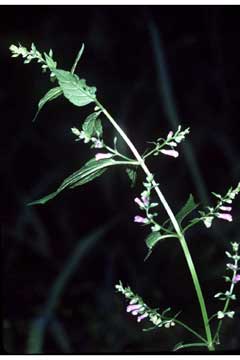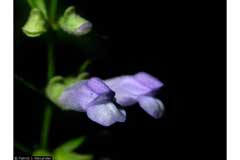 |
|
Robert H. Mohlenbrock @ USDA-NRCS PLANTS Database / USDA SCS. 1989. Midwest wetland flora: Field office illustrated guide to plant species. Midwest National Technical Center, Lincoln. |
 |
| Patrick J. Alexander @ USDA-NRCS PLANTS Database |
Translate this page:
Summary
Physical Characteristics

 Scutellaria lateriflora is a PERENNIAL growing to 0.6 m (2ft) by 0.4 m (1ft 4in).
Scutellaria lateriflora is a PERENNIAL growing to 0.6 m (2ft) by 0.4 m (1ft 4in).
See above for USDA hardiness. It is hardy to UK zone 7 and is not frost tender. It is in flower from June to August, and the seeds ripen from July to September. The species is hermaphrodite (has both male and female organs) and is pollinated by Bees, flies.
Suitable for: light (sandy), medium (loamy) and heavy (clay) soils. Suitable pH: mildly acid, neutral and basic (mildly alkaline) soils. It cannot grow in the shade. It prefers moist soil.
UK Hardiness Map
US Hardiness Map
Synonyms
Cassida lateriflora (L.) Moench
Plant Habitats
Woodland Garden Sunny Edge; Dappled Shade; Cultivated Beds;
Edible Uses
References More on Edible Uses
Medicinal Uses
Plants For A Future can not take any responsibility for any adverse effects from the use of plants. Always seek advice from a professional before using a plant medicinally.
Anticonvulsant Antispasmodic Astringent Diuretic Emmenagogue Epilepsy Miscellany Nervine
Sedative Tonic
A commonly used herbal medicine, Virginian skullcap is a very effective nervine that has traditionally been used in the treatment of a wide range of nervous conditions. Its tonic and restorative properties help to support and nourish the nervous system, calming and relieving stress and anxiety[222, 238, 244, 254]. Very little research has been carried out on this species, despite its long use in American and British herbal medicine[244]. Research is sorely needed, and may reveal more uses for this valuable herb[254]. The leaves are antispasmodic, slightly astringent, diuretic, nervine, sedative and strongly tonic[4, 21, 46, 165]. They are harvested in early summer and dried for later use[4]. It is used in the treatment of various problems of the nervous system including epilepsy, insomnia, anxiety, delirium tremens, withdrawal from barbiturates and tranquillisers, and neuralgia[222, 238, 244]. An infusion of the plant has been used to promote suppressed menstruation, relieve breast pain and encourage expulsion of the placenta[213, 254], it should not be given to pregnant women since it can induce a miscarriage[238]. This plant should be used with some caution since in excess it causes giddiness, stupor, confusion and twitching[238]. The plant was once believed of use in the treatment of rabies, though there is no evidence to support this[207, 213].
References More on Medicinal Uses
The Bookshop: Edible Plant Books
Our Latest books on Perennial Plants For Food Forests and Permaculture Gardens in paperback or digital formats.

Edible Tropical Plants
Food Forest Plants for Hotter Conditions: 250+ Plants For Tropical Food Forests & Permaculture Gardens.
More

Edible Temperate Plants
Plants for Your Food Forest: 500 Plants for Temperate Food Forests & Permaculture Gardens.
More

More Books
PFAF have eight books available in paperback and digital formats. Browse the shop for more information.
Shop Now
Other Uses
References More on Other Uses
Cultivation details
Succeeds in a sunny position in any ordinary garden soil that does not dry out during the growing season[200]. Plants are not so long-lived when grown in rich soils[4]. Many of the plants grown under this name in gardens are in fact S. altissima[238]. It is important to ensure you have the correct plant if using it medicinally[238]. In garden design, as well as the above-ground architecture of a plant, root structure considerations help in choosing plants that work together for their optimal soil requirements including nutrients and water. The root pattern is fleshy. Thick or swollen - fibrous or tap root [2-1].
References Carbon Farming Information and Carbon Sequestration Information
Temperature Converter
Type a value in the Celsius field to convert the value to Fahrenheit:
Fahrenheit:
The PFAF Bookshop
Plants For A Future have a number of books available in paperback and digital form. Book titles include Edible Plants, Edible Perennials, Edible Trees,Edible Shrubs, Woodland Gardening, and Temperate Food Forest Plants. Our new book is Food Forest Plants For Hotter Conditions (Tropical and Sub-Tropical).
Shop Now
Plant Propagation
Seed - sow in situ outdoors in late spring. If there is only a small quantity of seed it is better to sow it in a pot in a cold frame in early spring. When they are large enough to handle, prick the seedlings out into individual pots and plant them out in the spring. Division in spring just before new growth begins. Very easy, larger divisions can be planted out direct into their permanent positions. We have found it best to pot up the smaller divisions and grow them on in a lightly shaded position in a cold frame, planting them out once they are well established in the summer. Basal cuttings in early summer in a frame. Very easy. Harvest the shoots with plenty of underground stem when they are about 8 - 10cm above the ground. Pot them up into individual pots and keep them in light shade in a cold frame or greenhouse until they are rooting well. Plant them out in the summer.
Other Names
If available other names are mentioned here
Native Range
NORTHERN AMERICA: Canada (Québec, Nova Scotia, Ontario, Prince Edward Island, New Brunswick, Newfoundland and Labrador, Saskatchewan, Manitoba), United States (Indiana, Maine, Massachusetts, Michigan, New Hampshire, New Jersey, New York, Ohio, Pennsylvania, Rhode Island, Vermont, West Virginia, Connecticut, Illinois, Iowa, Kansas, Minnesota, Missouri, Nebraska, North Dakota, Oklahoma, South Dakota, Wisconsin, Colorado, Idaho, Oregon, Washington, Alabama, Arkansas, Delaware, Georgia, Kentucky, Louisiana, Maryland, North Carolina, South Carolina, Virginia, Mississippi, Tennessee, New Mexico, Texas, Arizona, California (east-central))
Weed Potential
Right plant wrong place. We are currently updating this section.
Please note that a plant may be invasive in one area but may not in your area so it's worth checking.
Conservation Status
IUCN Red List of Threatened Plants Status :

Growth: S = slow M = medium F = fast. Soil: L = light (sandy) M = medium H = heavy (clay). pH: A = acid N = neutral B = basic (alkaline). Shade: F = full shade S = semi-shade N = no shade. Moisture: D = dry M = Moist We = wet Wa = water.
Now available:
Food Forest Plants for Mediterranean Conditions
350+ Perennial Plants For Mediterranean and Drier Food Forests and Permaculture Gardens.
[Paperback and eBook]
This is the third in Plants For A Future's series of plant guides for food forests tailored to
specific climate zones. Following volumes on temperate and tropical ecosystems, this book focuses
on species suited to Mediterranean conditions—regions with hot, dry summers and cool, wet winters,
often facing the added challenge of climate change.
Read More
Expert comment
Author
L.
Botanical References
43235
Links / References
For a list of references used on this page please go here
Readers comment